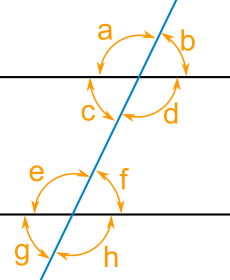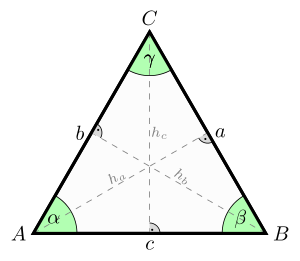Acute Angle: An acute angle ("acute" meaning "sharp") is an anglesmaller than a right angle (it is less than 90 degrees and more than 0 degrees).If you choose the larger angle you. will have a Reflex Angle instead. The smaller angle is anAcute Angle, but the larger angle is a Reflex Angle.
Obtuse Triangle:
An obtuse triangle is a triangle in which one of the angles is an obtuse angle. (Obviously, only a single angle in a triangle can be obtuse or it wouldn't be atriangle.) A triangle must be either obtuse, acute, or right.
Equilateral Triangle:
In geometry, an equilateral triangle is a triangle in which all three sides are equal. In the familiar Euclidean geometry, equilateral triangles are also equiangular; that is, all three internal angles are also congruent to each other and are each 60°.
Acute Triangle:
An acute triangle is a triangle with all three anglesacute (less than 90°). An obtuse triangle is one with one obtuse angle (greater than 90°) and two acuteangles. Since a triangle's angles must sum to 180°, no triangle can have more than one obtuse angle.
Adjacent Angles:
Two angles are Adjacent when they have a common side and a common vertex (corner point) and don't overlap.Angle ABC is adjacent to angle CBD. Because: they have a common side (line CB) they have a common vertex (point B)
Alternate Interior Angles. When two lines are crossed by another line (called the Transversal): The pairs of angles on opposite sides of the transversal but inside the two lines are called Alternate Interior Angles.
An obtuse triangle is a triangle in which one of the angles is an obtuse angle. (Obviously, only a single angle in a triangle can be obtuse or it wouldn't be atriangle.) A triangle must be either obtuse, acute, or right.
Equilateral Triangle:
In geometry, an equilateral triangle is a triangle in which all three sides are equal. In the familiar Euclidean geometry, equilateral triangles are also equiangular; that is, all three internal angles are also congruent to each other and are each 60°.
Linear Pair of Angles:
A linear pair of angles is formed when two lines intersect. Two angles are said to be linear if they are adjacent angles formed by two intersecting lines. The measure of a straight angle is 180 degrees, so alinear pair of angles must add up to 180 degrees.





Feel free to write